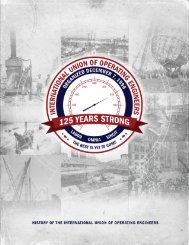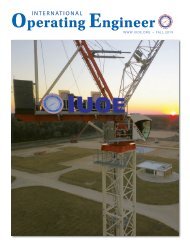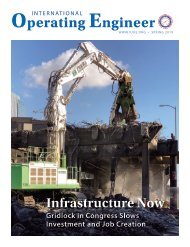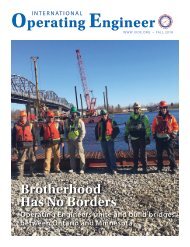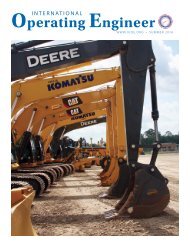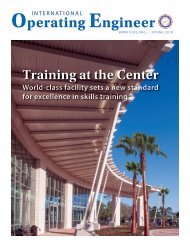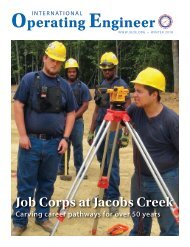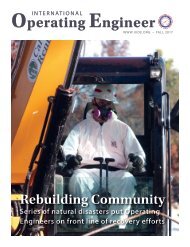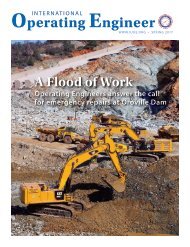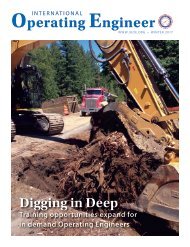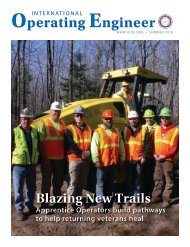International Operating Engineer - Spring 2016
The quarterly magazine of the International Union of Operating Engineers.
The quarterly magazine of the International Union of Operating Engineers.
You also want an ePaper? Increase the reach of your titles
YUMPU automatically turns print PDFs into web optimized ePapers that Google loves.
Canadian News<br />
Local 115: “We are BC’s dam builders!”<br />
Campaign questions lack of job guarantees for B.C. workers<br />
AT THE END OF MARCH, IUOE<br />
Local 115 ran an ad in a special section<br />
of the Vancouver Province newspaper<br />
titled “Building B.C.” This was part of<br />
the local’s ongoing efforts to pressure<br />
the British Columbia government and<br />
BC Hydro, the crown corporation that<br />
delivers power to the province, to use<br />
Project Labour Agreements for the Site<br />
C dam.<br />
Site C dam is an $8.3 billion mega<br />
project being built in northern B.C. on<br />
the Peace River and has been billed as<br />
the last large-scale dam that will ever be<br />
built in the province. “For the first time<br />
in over 50 years, <strong>Operating</strong> <strong>Engineer</strong>s<br />
are not the exclusive workers who will<br />
be completing this project. We are<br />
working hard to turn that around,” says<br />
Business Manager Brian Cochrane.<br />
The newspaper ad accompanied<br />
an article highlighting exactly why it is<br />
so important to hire local workers for<br />
projects paid for by British Columbian<br />
taxpayers, and why it is even more<br />
imperative to build those massive<br />
infrastructure investments using union<br />
labour. The article was widely circulated,<br />
and since then, media coverage has<br />
embraced the union’s stance that B.C.<br />
workers should be building the projects<br />
coming out of their taxes.<br />
Historically, Local 115 members<br />
have been B.C.’s dam builders. “During<br />
the 1960’s, when the majority of B.C.’s<br />
large power-producing dams were<br />
built, it was <strong>Operating</strong> <strong>Engineer</strong>s<br />
who exclusively built those major<br />
projects. This is the first time in more<br />
than 50 years BC Hydro and the B.C.<br />
government have moved away from<br />
the Project Labour Agreement model,”<br />
Cochrane explains.<br />
Everyone in British Columbia has<br />
benefited over many years from the<br />
legacy of the hydro dams built in past<br />
decades according to Cochrane. Those<br />
projects met the highest environmental<br />
standards and have produced reliable<br />
power for industry and communities to<br />
this day.<br />
However, in the first six months of<br />
this new project, there have been two<br />
breaches of environmental conditions<br />
caused by non-union crews. In addition,<br />
the company created a job posting for a<br />
human resources assistant where one<br />
of the outlined responsibilities was<br />
helping navigate the process required<br />
to bring in temporary foreign workers.<br />
That part of the job posting was later<br />
redacted when the media began asking<br />
questions, but that doesn’t mean the<br />
scope of the job has actually changed.<br />
Local 115 submitted several freedom<br />
of information requests on how many<br />
B.C. workers are employed on the<br />
project. Despite vague talking points<br />
repeated frequently by spokespeople<br />
for BC Hydro and the provincial<br />
government, the information showed<br />
that as little as 65 percent of workers<br />
on the project are local hires—even<br />
less considering that permanent<br />
administrative staff in a regional office<br />
were included in the numbers reported.<br />
The ads are part of a larger campaign<br />
to win a commitment to employ B.C.<br />
workers, and union workers, on the<br />
Site C dam, as well as future LNG<br />
projects currently under consideration<br />
by the Canadian federal government.<br />
A centerpiece of the campaign is a<br />
website titled, “Jobs for Northern BC”<br />
found at www.jobsfornorthernbc.<br />
ca. While spreading the campaign<br />
message, the website is also gathering<br />
the names, occupations and contact<br />
information of job seekers throughout<br />
British Columbia—those potentially<br />
looking for work on the Site C dam or<br />
future LNG projects.<br />
“Since our ad ran, BC Premier<br />
Christy Clark has made a big deal about<br />
awarding a small portion of the work to<br />
BC Building Trade unions, including<br />
<strong>Operating</strong> <strong>Engineer</strong>s. However, in the<br />
scope of the project, of the hundreds of<br />
workers employed on Site C, only four<br />
positions are going to IUOE Local 115<br />
members,” adds Cochrane.<br />
In light of this, Local 115 will<br />
continue to apply pressure to both<br />
BC Hydro and the B.C. government to<br />
hire local workers. They want to make<br />
sure the legacy of <strong>Operating</strong> <strong>Engineer</strong>s<br />
continues—they are, and will always be,<br />
B.C.’s dam builders.<br />
[above] The newspaper advertisement<br />
run by Local 115 as part of the “Jobs for<br />
Northern BC” campaign.<br />
[left] An artist rendering of the Site C Dam<br />
located on the Peace River in Northern<br />
British Columbia.<br />
20<br />
INTERNATIONAL OPERATING ENGINEER<br />
SPRING <strong>2016</strong> 21



